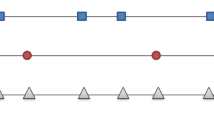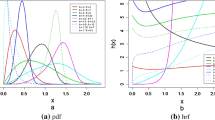Abstract
This paper follows the classical reliability approach of dealing with lifetime data. The models described are applicable to non-repairable systems or to repairable systems which are ‘new as bad as old’ [1], that is systems which have an underlying non-homogeneous Poisson process. The range of models in reliability is still remarkably restricted, lifetime analysis deals with a Poisson process but looks only at the time to first failure; models of repairable systems are at present the ‘good as new’ and ‘bad as old‘. ‘Good as new’ is described by renewal processes and ‘bad as old’ by non-homogeneous Poisson processes [1, 2, 3].
Access this chapter
Tax calculation will be finalised at checkout
Purchases are for personal use only
Preview
Unable to display preview. Download preview PDF.
Similar content being viewed by others
References
H. Ascher and M. Feingold, “Repairable Systems Reliability”, Marcel Dekker, 1984.
W.A. Thompson Jr., “On the Foundations of Reliability”, Technometrics, 23, 1–13, 1981.
J.F. Lawless, “Statistical Methods in Reliability”, Technometrics, 25, 305–335, 1983.
M.J. Newby, “Applications of Concepts of Aging in Reliability Data Analysis”, National Reliability Conference, Birmingham, April 1985.
D.G. Morrison and D.C. Schmittlein, “Jobs, Strikes, and Wars: Probability Models for Duration”, Organizational Behaviour and Human Performance, 25, 224–251, 1980.
E.J. Muth, “Reliability Models with Positive Memory Derived from the Mean Residual Life Function”, The Theory and Applications of Reliability, Vol. II, Academic Press, N.Y., 401–453, 1977.
M.C. Bryson and M.M. Siddiqui, “Some Criteria for Aging”, Journal of the American Statistical Association, 64, 1472–1483, 1969.
E.J. Muth., “An Optimal Decision Rule for Repair vs Replacement”, IEEE Transactions on Reliability, R-26, 179–181, 1977.
A.G. Laurent, “Wear and Aging: The Teissier Model”, Statistical Distributions in Scientific Work, Vol. 2, ed. G.P. Patil, D. Reidel, 1974.
R.E. Barlow and R. Campo, “Total Time on Test Processes and Applications to Failure Data Analysis”, Reliability and Fault Free Analysis, SIAM, Philadelphia, 451–481, 1975.
M.J. Newby, “Development of Generalised Methods for Reliability Data Analysis”, unpublished Ph.D. Thesis, University of Bradford, 1984.
C.L. Chiang, “Introduction to Stochastic Processes in Biostatistics”, Wiley, London, 1968.
E.L. Kaplan and P. Meier, “Nonparametric Estimation from Incomplete Observations”, Journal of the American Statistical Association, 53, 457–481, 1958.
Author information
Authors and Affiliations
Editor information
Editors and Affiliations
Rights and permissions
Copyright information
© 1986 Springer-Verlag Berlin, Heidelberg
About this paper
Cite this paper
Newby, M.J. (1986). Measures of Aging in Model Construction and Identification. In: Wingender, H.J. (eds) Reliability Data Collection and Use in Risk and Availability Assessment. Springer, Berlin, Heidelberg. https://doi.org/10.1007/978-3-642-82773-0_49
Download citation
DOI: https://doi.org/10.1007/978-3-642-82773-0_49
Publisher Name: Springer, Berlin, Heidelberg
Print ISBN: 978-3-642-82775-4
Online ISBN: 978-3-642-82773-0
eBook Packages: Springer Book Archive




